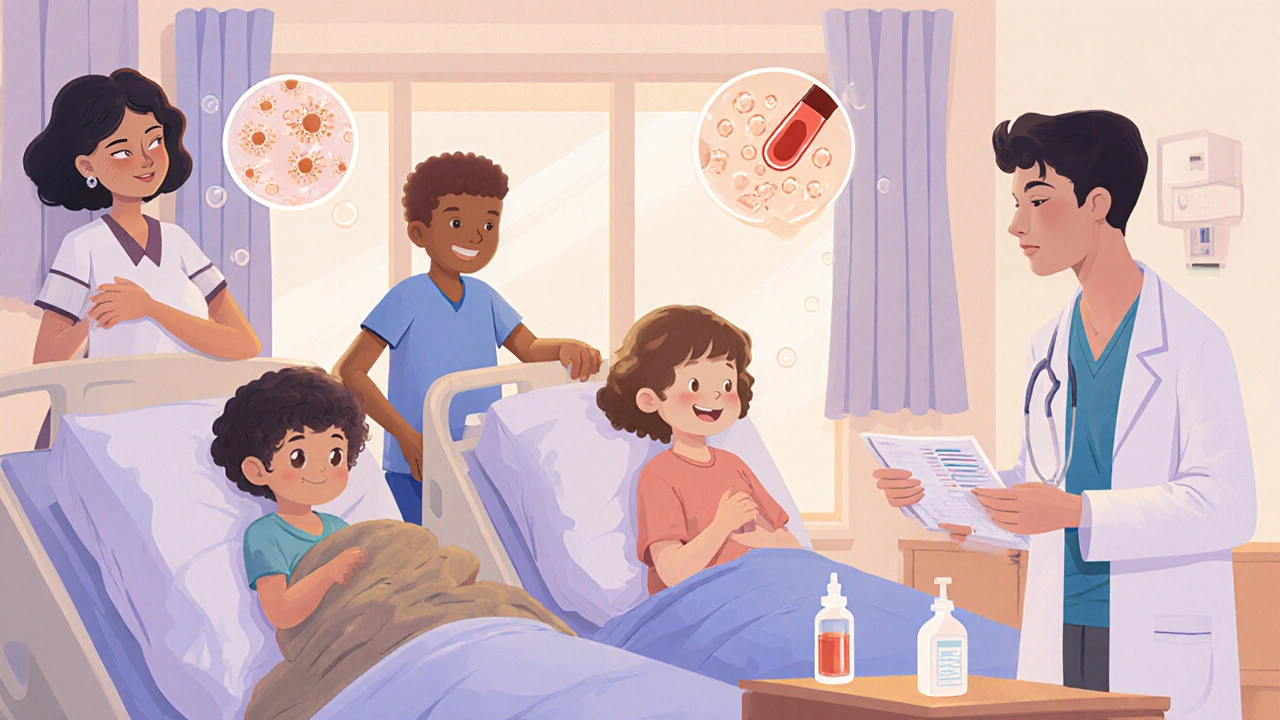How Candidemia and Disseminated Candida Infections Harm Children
28 Sep, 2025candidemia is a scary-sounding term, but at its core it means Candida yeast has invaded the bloodstream. When that happens in kids, the stakes are higher: their immune systems are still maturing, and the infection can spread to organs, turning into a disseminated Candida infection. Below you’ll find a quick‑hit TL;DR, followed by a step‑by‑step look at what the disease looks like in children, how doctors catch it, what treatments work, and what families can do to lower the risk.
TL;DR - Quick Takeaways
- Candidemia and disseminated Candida infections affect 0.5‑1.2 per 1,000 pediatric hospital admissions, with newborns and immunocompromised kids at highest risk.
- Fever, low blood pressure, and organ‑specific signs (e.g., abdominal pain, skin lesions) are common clues; blood cultures remain the gold‑standard diagnostic tool.
- Echinocandins (caspofungin, micafungin) and fluconazole are first‑line antifungal therapy for most children; dosing must be weight‑adjusted.
- Early therapy reduces mortality from ~30% to under 15% and shortens hospital stay by 4‑6 days on average.
- Prevention hinges on strict central line care, judicious antibiotic use, and early removal of unnecessary catheters.
What Exactly Is Candidemia?
When Candida - the most common yeast that lives on skin and mucous membranes - breaches the skin barrier and enters the bloodstream, doctors label the condition Candidemia is a bloodstream infection caused by Candida species that can lead to systemic disease if not treated promptly. The species most often responsible is Candida albicans which accounts for roughly 50‑60% of pediatric cases, followed by non‑albicans species like C. glabrata and C. parapsilosis.
When the Infection Spreads: Disseminated Candida Infection
If Candida travels beyond the bloodstream to organs such as the liver, spleen, kidneys, or eyes, the situation is called Disseminated Candida Infection is a multi‑organ invasion by Candida that can cause severe tissue damage and high mortality in children. In neonates, this often presents as hepatitis or meningitis, while older children may develop renal microabscesses or endophthalmitis.
Epidemiology: How Often Do Kids Get It?
Data from neonatal intensive care units (NICUs) across Australia and the United States show an incidence of 0.5‑1.2 episodes per 1,000 pediatric admissions. Two groups bear the brunt:
- Neonates are infants less than 28 days old, especially those born before 32 weeks gestation or weighing under 1,500g. Their immature immune systems and frequent use of central venous catheters make them vulnerable.
- Immunocompromised children are kids with malignancies, primary immunodeficiencies, or on high‑dose steroids, whose defenses are weakened. For them, candidemia can develop within a week of chemotherapy.
Overall mortality in pediatric candidemia hovers around 20‑30%, but when infection spreads to organs, the rate jumps to 40‑50% if therapy is delayed.
Clinical Picture: What to Look For
The signs are often vague, especially in newborns:
- Persistent fever despite broad‑spectrum antibiotics
- Unexplained hypotension or tachycardia
- Skin findings - pink macules, pustules, or necrotic lesions (often on the trunk)
- Abdominal distension or tenderness indicating hepatosplenic involvement
- Neurologic changes - irritability or seizures suggest CNS spread
Because the presentation overlaps with bacterial sepsis, clinicians rely heavily on laboratory confirmation.

Diagnostics: The Role of Blood Culture and Beyond
A Blood culture is the definitive test for Candida spp., requiring at least 10mL of blood in children and multiple sets to improve yield. Positive growth appears in 48‑72hours for most species, but C. glabrata can take up to 5 days.
Adjunct tools include (but do not replace) serum 1,3‑β‑D‑glucan, which rises early in invasive candidiasis, and PCR‑based assays that can identify species within 24hours. Imaging - abdominal ultrasound or CT - helps locate organ lesions when dissemination is suspected.
Treatment Landscape: Antifungal Therapy Choices
Current pediatric guidelines recommend an echinocandin as first‑line therapy for critically ill children, switching to fluconazole once the isolate is known to be susceptible.
| Drug | Spectrum | Typical Pediatric Dose | Key Toxicities |
|---|---|---|---|
| Micafungin | All Candida spp., including azole‑resistant strains | 2mg/kg IV once daily | Transient liver enzyme elevation |
| Caspofungin | Broad Candida coverage, limited C. parapsilosis | 50mg/m² IV loading, then 50mg/m² daily | Infusion‑related reactions, mild hepatotoxicity |
| Fluconazole | Most Candida spp. except resistant C. glabrata | 12mg/kg IV/PO daily (max 400mg) | Hepatotoxicity, QT prolongation (rare) |
| Amphotericin B (lipid) | Broad, including rare molds | 3mg/kg IV daily | Kidney injury, infusion fever |
Therapy duration is usually 2‑3weeks after the first negative blood culture and clinical resolution. For disseminated disease, extend treatment to at least 4‑6weeks and monitor organ function with serial imaging.
Impact on Outcomes: Mortality, Morbidity, and Hospital Stay
Early initiation of appropriate antifungal therapy cuts mortality by roughly 50%. A multicenter Australian study reported an average Mortality rate is the proportion of patients who die within 30 days of candidemia onset, estimated at 22% for children receiving timely therapy. Children who survive often face lingering issues:
- Renal scarring after Candida‑related pyelonephritis
- Visual impairment from endophthalmitis
- Neurodevelopmental delays if CNS infection occurred
Length of stay drops from a median of 28days to 18days when antifungal treatment starts within 24hours of culture positivity, saving hospitals substantial resources.
Prevention: What Hospitals and Families Can Do
Because many risk factors are iatrogenic, prevention focuses on medical practices:
- Central line bundles: strict aseptic insertion, daily review, and prompt removal when no longer needed.
- Antibiotic stewardship: limiting broad‑spectrum antibiotics that disrupt normal flora.
- Prophylactic fluconazole in high‑risk NICU patients (birth weight <1,000g) reduces candidemia incidence by up to 70%.
- Oral hygiene for ventilated children, as oral colonization precedes bloodstream spread.
Parents can also help by ensuring hand hygiene before touching catheters or feeding tubes and by asking the care team about the necessity of each invasive device.
Key Takeaway Checklist
- Suspect candidemia in any child with persistent fever, especially neonates or those on chemotherapy.
- Obtain at least two sets of blood cultures before starting antifungals.
- Start an echinocandin (micafungin or caspofungin) promptly; switch to fluconazole if susceptible.
- Monitor liver enzymes and renal function throughout treatment.
- Remove unnecessary central lines within 48hours of diagnosis.
- Plan at least 2‑3weeks of therapy after the last positive culture; extend for organ involvement.

Frequently Asked Questions
How is candidemia different from a regular yeast infection?
A typical yeast infection stays on the skin or mucous membranes. Candidemia means the yeast has entered the bloodstream, allowing it to travel to organs and cause far more severe disease.
Can a child recover fully after disseminated Candida infection?
Many children do recover, but the outcome depends on which organs were involved and how quickly treatment began. Early, aggressive therapy gives the best chance of avoiding permanent damage.
What are the most common side effects of the antifungal drugs used?
Echinocandins can cause mild liver enzyme rises; fluconazole may lead to liver issues or rare heart rhythm changes; amphotericin B is notorious for kidney injury. Monitoring labs helps catch problems early.
Should healthy children avoid antibiotics to prevent candidemia?
Antibiotics themselves don’t cause candidemia, but unnecessary broad‑spectrum use can wipe out protective bacteria, allowing Candida to overgrow. So, only use antibiotics when truly needed.
Is there a vaccine against Candida for kids?
Research is ongoing, but no licensed vaccine exists yet. Prevention currently relies on infection‑control practices and targeted prophylaxis for high‑risk groups.
How long should a central line stay in place after a child has candidemia?
Guidelines suggest removing the line as soon as possible, ideally within 48hours, unless it’s absolutely necessary for life‑supporting therapy.
Can home care teams manage antifungal therapy after discharge?
Yes, many hospitals transition stable patients to oral fluconazole or outpatient IV echinocandin infusions, provided families receive proper education and monitoring plans.

Dustin Hardage
September 28, 2025 AT 06:34Early recognition of candidemia in pediatric patients is paramount, as delayed therapy markedly increases mortality. The literature consistently shows that initiating echinocandin treatment within 24 hours can halve the risk of death. Moreover, weight‑adjusted dosing ensures therapeutic levels without undue toxicity. Clinicians should also prioritize obtaining adequate blood culture volumes to improve diagnostic yield. Finally, a multidisciplinary approach involving infectious disease, pharmacy, and nursing teams optimizes outcomes.
Janae Johnson
October 4, 2025 AT 01:28While the statistics are concerning, one must question whether the incidence rates truly reflect modern practice; surveillance definitions vary widely. In many institutions, aggressive antifungal prophylaxis already blunts the numbers cited. Nonetheless, the data serve as a reminder that vigilance cannot become complacent.
Kayla Charles
October 9, 2025 AT 20:21Thank you all for sharing such valuable insights; I’d like to expand on a few points that often get overlooked in these discussions. First, the psychosocial impact on families dealing with a prolonged hospital stay is profound, and institutions should provide robust support services. Second, in neonates, the pharmacokinetics of echinocandins differ dramatically from older children, necessitating therapeutic drug monitoring wherever possible. Third, the role of fungal biomarkers such as 1,3‑β‑D‑glucan is evolving, and early elevation can prompt pre‑emptive therapy even before cultures turn positive. Fourth, central line‑associated bloodstream infections remain a leading modifiable risk factor; strict adherence to insertion bundles and daily necessity assessments cannot be overstated. Fifth, antibiotic stewardship programs not only reduce bacterial resistance but also diminish the dysbiosis that predisposes to Candida overgrowth. Sixth, when disseminated disease is suspected, early imaging-particularly abdominal ultrasound-can uncover hidden organ involvement, guiding duration of therapy. Seventh, the choice between micafungin and caspofungin often hinges on local susceptibility patterns and cost considerations, so formulary committees should remain agile. Eighth, lipid‑formulation amphotericin B, while nephrotoxic, may be lifesaving in azole‑resistant cases and should be kept in reserve. Ninth, education of bedside nurses about the subtle cutaneous signs of Candida infection can lead to earlier diagnosis. Tenth, there is growing evidence that probiotic supplementation, when used judiciously, might restore microbial balance and lower invasive fungal infection rates. Eleventh, families should be taught proper line care at home if early discharge is planned, reducing the risk of post‑discharge infections. Twelfth, multidisciplinary rounds that include a pediatric infectious disease pharmacist have been shown to shorten time to appropriate antifungal initiation. Thirteenth, ongoing research into novel antifungal agents, such as rezafungin, promises longer dosing intervals that could be advantageous in outpatient settings. Fourteenth, data suggest that patients who survive candidemia often experience long‑term sequelae, such as renal scarring, emphasizing the need for careful post‑discharge follow‑up. Fifteenth, institutional quality metrics should track not only mortality but also time to first appropriate antifungal and line removal rates. Finally, sharing these findings across networks via registries can accelerate learning and ultimately improve patient outcomes across the board.
Paul Hill II
October 15, 2025 AT 15:14I agree with the earlier point about central‑line bundles; in our unit we’ve instituted daily “line‑pause” huddles that have cut catheter‑associated infections by roughly 30 %.
Stephanie Colony
October 21, 2025 AT 10:08It’s amusing how often American hospitals boast about their cutting‑edge protocols while ignoring the simple truth that disciplined line care is a universal principle, not a patriotic innovation. The color‑ful jargon about "state‑of‑the‑art" therapies often masks the fact that basic aseptic technique still saves lives.
Abigail Lynch
October 27, 2025 AT 04:01Honestly, I suspect big pharma is pushing fluconazole prophylaxis to keep us dependent on their drugs, while they hide data about long‑term resistance. The drama surrounding these infections feels manufactured to sell more expensive antifungals.
David McClone
November 1, 2025 AT 22:54Oh sure, blame the drug companies for everything while ignoring the fact that sterile technique hasn't changed in centuries-it's not exactly a blockbuster revelation.
Jonathan Alvarenga
November 7, 2025 AT 17:48The guidelines are certainly thorough, but their sheer length can be overwhelming for bedside clinicians who need quick decision‑making tools. A condensed algorithm highlighting when to start an echinocandin versus when to wait for culture confirmation would be far more practical. Additionally, the recommendations on dosing adjustments for renal impairment are buried deep within tables, making them easy to miss during a hectic shift. In my experience, a pocket‑size cheat sheet could bridge this gap and improve adherence to best practices.
Jim McDermott
November 13, 2025 AT 12:41Thats a good point i think a cheat sheet would help a lot especially for the new resident who might not be familiar with the full guidlines lol
Naomi Ho
November 19, 2025 AT 07:34Early antifungal therapy really does cut mortality.
Christine Watson
November 25, 2025 AT 02:28Absolutely! Every extra hour before treatment can make a huge difference for kids-let’s keep spreading the word.
Macy Weaver
November 30, 2025 AT 21:21I wonder how often families are educated about line care before discharge; providing clear instructions could prevent readmissions.
James McCracken
December 6, 2025 AT 16:14One could argue that the very notion of “education” is a construct that obscures the underlying power dynamics between clinicians and caregivers.
Evelyn XCII
December 12, 2025 AT 11:08Sure, blame the system-but hey, at least we have guidelines to point at, right?
Suzanne Podany
December 18, 2025 AT 06:01Let’s keep supporting each other and sharing practical tools-together we can make candidemia outcomes better for every child.